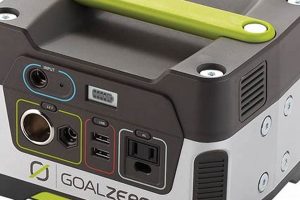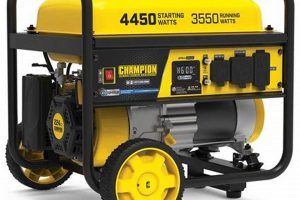The stability and consistency of electricity produced by compact, mobile generators is a critical factor for many applications. This characteristic, determined by factors like voltage regulation, frequency stability, and harmonic distortion, directly impacts the performance and lifespan of connected devices. For instance, sensitive electronics like computers and medical equipment require a clean, consistent power supply to function correctly. Fluctuations or deviations can lead to malfunctions, data loss, or even equipment damage.
Reliable electricity from these power sources is essential in various scenarios, ranging from emergency backup power during outages to providing electricity in remote locations or for outdoor events. Historically, these generators were primarily used for basic power needs. However, with advancements in technology and the increasing reliance on sensitive electronic devices, the demand for improved electrical stability from these units has grown significantly. This improved stability minimizes the risk of equipment damage and ensures consistent performance, even under fluctuating loads.
This discussion will further explore the technical aspects of generating stable electricity using portable units, including voltage regulation mechanisms, frequency control, and the impact of harmonic distortion. It will also address practical considerations for users, such as selecting the right generator for specific needs and best practices for maintaining stable power output in various operating conditions.
Tips for Maintaining Optimal Generator Performance
Maintaining the stability and consistency of electricity generated by portable units is crucial for ensuring the safe and effective operation of connected devices. The following tips offer practical guidance for achieving optimal performance and minimizing potential issues.
Tip 1: Select the Appropriate Generator Size: Accurately assess power requirements before selecting a generator. Connecting devices that exceed the generator’s rated capacity can lead to voltage drops, frequency instability, and potential damage to both the generator and connected equipment. Consult manufacturer specifications and calculate the total wattage required by all intended devices.
Tip 2: Regularly Inspect and Maintain the Generator: Routine maintenance, including oil changes, air filter cleaning, and spark plug replacement, is essential for reliable operation and consistent power output. Refer to the manufacturer’s recommendations for specific maintenance schedules and procedures.
Tip 3: Use Clean Fuel: Contaminated or stale fuel can negatively impact generator performance and stability. Always use fresh, clean fuel and store fuel appropriately to prevent contamination.
Tip 4: Manage Electrical Loads: Avoid overloading the generator by connecting devices strategically. Distribute loads evenly and prioritize essential equipment. Consider using power management devices to monitor and control power consumption.
Tip 5: Protect Against Electrical Surges: Voltage surges can damage sensitive electronics connected to the generator. Employ surge protectors to safeguard equipment and maintain stable power delivery.
Tip 6: Monitor Generator Output: Periodically monitor voltage and frequency levels using a multimeter to ensure they remain within acceptable ranges. Deviations from these ranges can indicate potential problems requiring attention.
Tip 7: Provide Adequate Ventilation: Generators produce exhaust fumes containing carbon monoxide, a colorless, odorless, and poisonous gas. Ensure adequate ventilation around the generator and never operate it in enclosed spaces.
Adhering to these practices will contribute to a stable and reliable power supply, protecting connected equipment and ensuring consistent performance. This proactive approach minimizes downtime and extends the lifespan of the generator.
By understanding these key factors influencing stable power generation, users can make informed decisions and implement best practices for safe and effective operation in various applications.
1. Voltage Regulation
Voltage regulation is a critical determinant of portable generator power quality, directly impacting the performance and lifespan of connected devices. Maintaining a consistent voltage output, even under varying load conditions, is essential for preventing damage and ensuring reliable operation. This discussion explores the key facets of voltage regulation and their implications for portable generator performance.
- Impact of Load Changes
Voltage fluctuations occur as the electrical load on a generator changes. A sudden increase in demand can cause a voltage drop, while a decrease can lead to a voltage surge. Effective voltage regulation minimizes these fluctuations, ensuring a stable supply regardless of load variations. For example, a generator powering a construction site might experience load changes as different power tools are used. Robust voltage regulation ensures consistent power delivery, preventing tool damage and maintaining operational efficiency.
- Automatic Voltage Regulators (AVRs)
AVRs are essential components within portable generators that automatically adjust the generator’s output to maintain a stable voltage level. They compensate for load variations, ensuring that the voltage supplied to connected devices remains within acceptable limits. High-quality AVRs are crucial for maintaining consistent power quality, especially when powering sensitive electronics.
- Types of Voltage Regulation Methods
Several voltage regulation methods exist, each with its own advantages and disadvantages. These include electronic voltage regulators (most common in portable generators), transformer voltage regulators, and ferroresonant regulators. The choice of regulator depends on the generator’s size, application, and desired level of voltage stability. Understanding these different methods helps in selecting the appropriate generator for specific needs.
- Consequences of Poor Voltage Regulation
Inadequate voltage regulation can have significant consequences, including damage to connected equipment, reduced equipment lifespan, and unreliable operation. Voltage fluctuations can cause overheating, data loss in electronic devices, and premature motor failure in appliances. Investing in a generator with robust voltage regulation is crucial for mitigating these risks.
Effective voltage regulation is thus a cornerstone of high-quality power delivery from portable generators. By understanding the mechanisms of voltage regulation and the consequences of instability, users can make informed decisions and ensure the safe and reliable operation of their connected devices.
2. Frequency Stability
Frequency stability is a fundamental aspect of portable generator power quality, directly influencing the proper function of connected devices. Maintaining a consistent frequency, typically 50Hz or 60Hz depending on the region, is crucial for preventing equipment malfunctions and ensuring reliable operation. This discussion delves into the critical facets of frequency stability and their implications for portable generator performance.
- Impact on Motor Speed
AC motors, commonly used in various appliances and tools, rely on a stable frequency to maintain their designed speed. Frequency deviations can lead to motor speed variations, impacting performance and potentially causing damage. For instance, a fluctuating frequency could affect the speed of a refrigerator compressor, hindering its cooling efficiency.
- Generator Speed Control
Maintaining a constant generator speed is crucial for stable frequency output. Generators employ speed governors to regulate engine speed and compensate for load changes, ensuring consistent frequency. The governor’s responsiveness and accuracy directly influence the overall frequency stability of the generator.
- Sensitivity of Electronic Devices
Certain electronic devices, particularly those with timing circuits, are highly sensitive to frequency variations. Fluctuations can disrupt their operation, leading to malfunctions or inaccurate readings. Clocks, timers, and some types of medical equipment are particularly susceptible to frequency instability.
- Consequences of Frequency Instability
Operating equipment outside its specified frequency range can lead to various issues, including overheating, reduced equipment lifespan, and malfunction. Inaccurate frequency can also affect the accuracy of measuring instruments and disrupt the operation of sensitive electronics. Ensuring stable frequency is therefore essential for maintaining the integrity and performance of connected devices.
Frequency stability is thus a cornerstone of reliable power delivery from portable generators. Understanding the factors influencing frequency and the potential consequences of instability allows users to prioritize this critical aspect and ensure optimal performance of connected devices.
3. Harmonic Distortion
Harmonic distortion represents a significant factor influencing portable generator power quality. It arises from the non-linear loads connected to the generator, which draw current in pulses rather than smoothly, creating additional frequencies (harmonics) that distort the fundamental frequency waveform. This distortion can negatively impact both the generator itself and the connected devices.
The effects of harmonic distortion manifest in various ways. Within the generator, it can lead to increased heating in windings and other components, potentially shortening the generator’s lifespan. For connected devices, harmonic distortion can cause malfunctions in sensitive electronics, overheating in motors, and reduced efficiency in appliances. For example, harmonic distortion might cause flickering in lights, erratic behavior in computer systems, or overheating in audio equipment. The severity of these effects depends on the magnitude of the harmonic distortion, often quantified as Total Harmonic Distortion (THD).
Mitigating harmonic distortion involves several strategies. Selecting generators with robust designs that minimize inherent harmonic generation is crucial. Utilizing filtering devices can suppress harmonics present in the generator’s output. Proper load management, avoiding overloading the generator, and strategically connecting non-linear loads can also contribute to reducing harmonic content. Understanding the relationship between harmonic distortion and power quality allows for informed decisions in generator selection, operation, and load management, ultimately ensuring reliable power delivery and preventing equipment damage.
4. Total Harmonic Distortion (THD)
Total Harmonic Distortion (THD) serves as a critical metric for quantifying the purity of AC power generated by portable units. It represents the percentage of distortion present in the voltage or current waveform compared to the fundamental frequency (typically 50Hz or 60Hz). Lower THD values indicate cleaner power, signifying a closer resemblance to a pure sinusoidal waveform, while higher THD values indicate greater distortion and the presence of unwanted harmonic frequencies.
The primary cause of THD in portable generators stems from non-linear loads. These loads, such as electronic power supplies, variable speed drives, and LED lighting, draw current in non-sinusoidal patterns, introducing harmonic frequencies into the power system. These harmonics distort the voltage and current waveforms, potentially leading to detrimental effects on both the generator and connected devices. For instance, a generator powering a construction site with numerous power tools and LED lights may exhibit higher THD due to the non-linear load characteristics of these devices. High THD can cause overheating in the generator windings, reduced efficiency, and premature component failure. Connected devices, especially sensitive electronics, may experience malfunctions, data corruption, or even permanent damage. For example, high THD can disrupt the operation of medical equipment, sensitive laboratory instruments, and computer systems.
Minimizing THD is essential for ensuring optimal performance and longevity of both the generator and connected devices. Selecting generators with inherently low THD ratings, achieved through robust design and quality components, constitutes a fundamental step. Employing filtering devices designed to attenuate harmonic frequencies can further improve power quality. Effective load management strategies, such as balancing loads and avoiding overloading the generator, also contribute to reducing harmonic content. Understanding THD and its implications empowers users to make informed decisions regarding generator selection, load management, and the implementation of mitigation strategies, ultimately ensuring a clean and reliable power supply for sensitive equipment and maximizing the lifespan of the generator itself.
5. Clean Power Delivery
Clean power delivery is paramount for ensuring the reliable operation of sensitive electronic equipment powered by portable generators. It signifies a stable power supply free from significant voltage fluctuations, frequency deviations, and harmonic distortions. This characteristic is intrinsically linked to overall power quality, impacting the performance, lifespan, and safety of connected devices. A clean power supply minimizes the risk of malfunctions, data loss, and equipment damage, especially for electronics like computers, medical devices, and precision instruments.
- Stable Voltage and Frequency
Maintaining consistent voltage and frequency levels is fundamental to clean power delivery. Voltage fluctuations can cause erratic behavior or damage to electronic components, while frequency instability can affect the operation of devices reliant on precise timing, such as clocks and motors. For instance, a voltage drop might cause a computer to shut down unexpectedly, while a frequency deviation could affect the speed of a pump motor. Consistent voltage and frequency ensure the stable and predictable operation of connected equipment.
- Minimal Harmonic Distortion
Harmonic distortion, introduced by non-linear loads, degrades power quality by injecting unwanted frequencies into the power supply. These harmonics can cause overheating in equipment, generate noise in audio systems, and disrupt the operation of sensitive electronics. Minimizing harmonic distortion, often measured as Total Harmonic Distortion (THD), is crucial for clean power delivery. For example, high THD could damage sensitive medical equipment or introduce errors in laboratory measurements.
- Effective Surge Protection
Electrical surges, often caused by lightning strikes or grid switching, pose a significant threat to electronic equipment. Clean power delivery necessitates robust surge protection mechanisms to prevent these transient voltage spikes from reaching connected devices. Surge protectors divert excess voltage to ground, safeguarding sensitive electronics from damage. This protection is especially critical in areas prone to power fluctuations.
- Grounding and Electrical Noise Reduction
Proper grounding practices and electrical noise reduction techniques are essential for clean power delivery. A solid ground connection provides a safe path for fault currents, protecting users and equipment. Minimizing electrical noise, often caused by electromagnetic interference, reduces unwanted signals that can disrupt sensitive electronics. This contributes to stable and reliable operation, particularly for devices susceptible to interference, such as communication equipment.
These facets of clean power delivery are integral to ensuring the reliable and safe operation of electronic devices powered by portable generators. By prioritizing these elements, users can mitigate the risks associated with power quality issues, maximizing equipment lifespan and minimizing disruptions. This ultimately contributes to enhanced productivity and safety in various applications, from emergency power supply during outages to providing electricity in remote locations.
Frequently Asked Questions about Portable Generator Power Quality
This section addresses common inquiries regarding the stability and consistency of electricity produced by portable generators, aiming to provide clear and concise information for informed decision-making.
Question 1: How does generator size influence power quality?
Generator size, relative to connected load, directly impacts power quality. Undersized generators struggle to maintain voltage and frequency under heavy load, leading to instability. Oversized generators operate inefficiently and may not provide adequate voltage regulation at low loads. Accurate load calculation is essential for selecting the appropriately sized generator to ensure stable power delivery.
Question 2: What is the significance of Total Harmonic Distortion (THD)?
THD quantifies the distortion in the generator’s output waveform. High THD can damage sensitive electronics and reduce equipment efficiency. Lower THD indicates cleaner power, crucial for protecting sophisticated devices.
Question 3: How can voltage fluctuations be mitigated?
Employing a generator equipped with an Automatic Voltage Regulator (AVR) helps maintain consistent voltage output despite load changes. Selecting a generator with a robust AVR and appropriate load management practices minimize voltage fluctuations.
Question 4: What causes frequency instability in portable generators?
Frequency instability typically arises from variations in engine speed. Generators employ speed governors to maintain consistent frequency, but fluctuations can occur due to load changes or governor malfunction. Regular maintenance and proper load management are crucial for maintaining frequency stability.
Question 5: Why is clean power delivery essential for sensitive electronics?
Sensitive electronics, including computers and medical devices, require stable voltage, frequency, and minimal harmonic distortion for reliable operation. Clean power prevents malfunctions, data corruption, and potential equipment damage.
Question 6: How does proper generator maintenance contribute to power quality?
Regular maintenance, such as oil changes, air filter cleaning, and spark plug replacement, ensures optimal generator performance. Neglecting maintenance can lead to instability in voltage and frequency, compromising power quality and potentially damaging the generator.
Maintaining stable and consistent power from a portable generator necessitates careful consideration of various factors, from generator sizing and load management to harmonic distortion and proper maintenance. Understanding these factors empowers users to protect connected equipment and ensure reliable operation in diverse applications.
For further technical details and specific recommendations regarding portable generator power quality, please consult the subsequent sections of this resource.
Conclusion
Stable and consistent electricity from portable generators, characterized by well-regulated voltage, stable frequency, and minimal harmonic distortion, is paramount for reliable operation of sensitive equipment and overall system integrity. This exploration has highlighted the critical interplay between generator selection, load management, and maintenance practices in achieving optimal power quality. The detrimental consequences of neglecting these factors, including equipment damage, data loss, and operational disruptions, underscore the necessity of a comprehensive approach to power quality management. Addressing total harmonic distortion and ensuring clean power delivery further safeguards connected devices and prolongs their lifespan.
As technology advances and reliance on portable generators increases across various sectors, maintaining high power quality becomes increasingly critical. Investing in robust generators, implementing best practices for operation and maintenance, and understanding the intricacies of power quality parameters will be essential for ensuring reliable power delivery and mitigating potential risks in the future. Prioritizing portable generator power quality ultimately translates to enhanced safety, efficiency, and equipment longevity, driving uninterrupted productivity across diverse applications.






